

DNA Study Adds Another Piece to the Puzzle of Pacific Colonisation. What do you do if you have limited historical data and a lot of questions awaiting answers?

You turn to genetic research. This is what researchers did when trying to reconstruct the routes of ancient Polynesians, who left behind little archaeological evidence but a tiny yet powerful indicator: a genetic trail. Scientists have used DNA analysis to recreate their heroic voyages through time and space, spanning over 500 years and more than 5,000 kilometres of treacherous waters of the Pacific Ocean. The settlement of Polynesia is one of the most remarkable achievements in the history of human migration and navigation, yet, little is known as to when the colonisation of the islands took place and which order it followed.
The expansion was done astonishingly fast, outrunning the evolving dialects or cultural practices that would usually serve as anthropological markers. Face to face with the prehistoric inhabitants of El Argar. Our faces contain information about our family history and lifestyle.
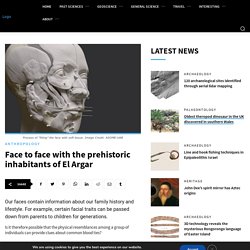
For example, certain facial traits can be passed down from parents to children for generations. Is it therefore possible that the physical resemblances among a group of individuals can provide clues about common blood ties? How Do We Know What Neanderthals Looked Like? 3,000-year-old shark attack victim found by Oxford-led researchers. (the “Website”), is operated by HERITAGEDAILY What are cookies?
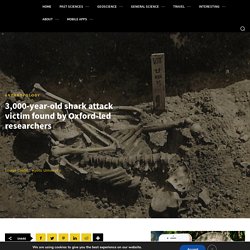
Cookies are small text files that are stored in the web browser that allows HERITAGEDAILY or a third party to recognise you. Cookies can be used to collect, store and share bits of information about your activities across websites, including on the HERITAGEDAILY website and subsidiary brand website. Cookies can be used for the following purposes: – To enable certain functions – To provide analytics – To store your preferences – To enable ad delivery and behavioural advertising. A child’s 78,000-year-old grave marks Africa’s oldest human burial. A child whose lifeless body was carefully placed in an East African cave around 78,300 years ago has made a grand return.
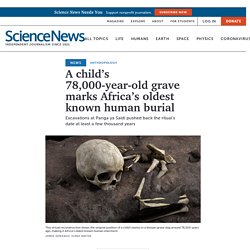
Researchers who unearthed the ancient youngster’s remains say that they’ve found the oldest known intentional human burial in Africa. The investigators, who report the discovery in the May 6 Nature, have named the ancient youngster Mtoto, a Swahili word that means “child.” “Mtoto was buried in a sheltered part of a cave that was repeatedly occupied by people over a span of nearly 80,000 years, up to about 500 years ago,” said archaeologist Michael Petraglia of the Max Planck Institute for the Science of Human History in Jena, Germany, at a May 3 news conference.
Local people still visit this spot to worship and conduct rituals. Sign Up For the Latest from Science News Headlines and summaries of the latest Science News articles, delivered to your inbox. Study Suggests Environmental Factors Had a Role in the Evolution of Human Tolerance. Environmental pressures may have led humans to become more tolerant and friendly towards each other as the need to share food and raw materials became mutually beneficial, a new study suggests.

This behaviour was not an inevitable natural progression, but subject to ecological pressures, the University of York study concludes. Humans have a remarkable capacity to care about people well outside their own kin or local group. Whilst most other animals tend to be defensive towards those in other groups our natural tolerance allows us to collaborate today on a global scale, as seen with trade or international relief efforts to provide aid for natural disasters. Using computer simulations of many thousands of individuals gathering resources for their group and interacting with individuals from other groups, the research team attempted to establish what key evolutionary pressures may have prompted human intergroup tolerance.
Dr Jennifer C. The oldest known abrading tool was used around 350,000 years ago. A round stone excavated at Israel’s Tabun Cave in the 1960s represents the oldest known grinding or rubbing tool, say researchers who scrutinized the 350,000-year-old find.
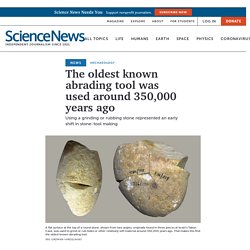
The specimen marks a technological turn to manipulating objects with wide, flat stone surfaces, say Ron Shimelmitz, an archaeologist at the University of Haifa in Israel, and his colleagues. Up to that time, stone implements had featured thin points or sharp edges. Microscopic wear and polish on a worn section of the Tabun stone resulted from it having been ground or rubbed against relatively soft material, such as animal hides or plants, the scientists conclude in the January Journal of Human Evolution.
Similar stones bearing signs of abrasion date to no more than around 200,000 years ago. Specific ways in which the Tabun stone was used remain a mystery. Janat00554 0167. Shrine of decapitated heads suggests violence against foreigners in ancient Mexico. Fifteen hundred years ago, Mexico’s Teotihuacan was a multicultural metropolis, enlivened by the diverse dress, foods, and dialects of its immigrant groups.
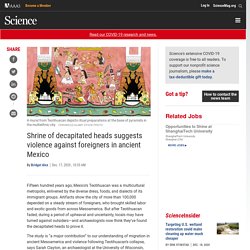
Artifacts show the city of more than 100,000 depended on a steady stream of foreigners, who brought skilled labor and exotic goods from across Mesoamerica. But after Teotihuacan faded, during a period of upheaval and uncertainty, locals may have turned against outsiders—and archaeologists now think they’ve found the decapitated heads to prove it. The study is “a major contribution” to our understanding of migration in ancient Mesoamerica and violence following Teotihuacan’s collapse, says Sarah Clayton, an archaeologist at the University of Wisconsin, Madison, who was not involved in the research.
The apocalypse of the Inca empire [timeline] Extinct Early Humans Socially Ate Out. An ancient archaeological site in Sussex, dating from almost half a million years ago gives insights into the life and eating habits of extinct human species.
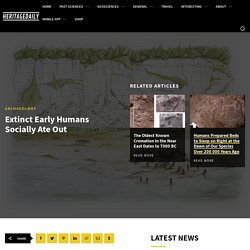
In a new study by the University College London (UCL), archaeologists have pieced together the movements of early humans as they made tools and butchered a horse some 480,000 years ago. The butchery site is one of several locations found in quarries near Boxgrove in Sussex, that was excavated in the 1980s and 90s by UCL under the leadership of Mark Roberts. Dr Matthew Pope, Project lead from UCL said: “This was an exceptionally rare opportunity to examine a site pretty much as it had been left behind by an extinct population, after they had gathered to totally process the carcass of a dead horse on the edge of a coastal marshland.”
Humans Prepared Beds to Sleep on Right at the Dawn of Our Species Over 200 000 Years Ago. Researchers in South Africa’s Border Cave, a well-known archaeological site perched on a cliff between eSwatini (Swaziland) and KwaZulu-Natal in South Africa, have found evidence that people have been using grass bedding to create comfortable areas for sleeping and working on at least 200 000 years ago.

These beds, consisting of sheaves of grass of the broad-leafed Panicoideae subfamily were placed near the back of the cave on ash layers. The layers of ash was used to protect the people against crawling insects while sleeping. Today, the bedding layers are visually ephemeral traces of silicified grass, but they can be identified using high magnification and chemical characterisation. “We speculate that laying grass bedding on ash was a deliberate strategy, not only to create a dirt-free, insulated base for the bedding, but also to repel crawling insects,” says Professor Lyn Wadley, principal researcher and lead author.
Header Image Credit : Lyn Wadley/Wits University. Ancient DNA suggests Vikings may have been plagued by smallpox. Some Vikings may have died from now-extinct strains of one of humankind’s deadliest pathogens: smallpox.
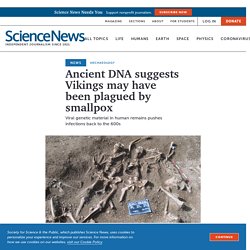
Researchers collected DNA from viruses in the remains of northern Europeans living during the Viking Age, some of whom were likely Vikings themselves, and found that they were infected with extinct but related versions of the variola virus that causes smallpox, the team reports in the July 24 Science. The new finding pushes back the proven record of smallpox infecting people by almost 1,000 years, to the year 603. Researchers had previously discovered ancient traces of variola virus DNA in a mummy from the mid-1600s, which put the common origin of modern strains in the 16th or 17th century (SN: 12/8/16). It is still uncertain when the virus that causes smallpox first began to infect people. The disease is estimated to have killed as many as 500 million people and is the only human pathogen to have been eradicated globally.
Remains found by Pompeii really are Pliny the Elder, new tests indicate - Archaeology. 3,000-year-old teeth solve Pacific banana mystery. - Advertisement - Humans began transporting and growing banana in Vanuatu 3000 years ago, a University of Otago scientist has discovered.
The discovery is the earliest evidence of humans taking and cultivating banana in to what was the last area of the planet to be colonised. In an article published this week in Nature Human Behaviour, Dr Monica Tromp, Senior Laboratory Analyst at the University of Otago’s Southern Pacific Archaeological Research (SPAR), found microscopic particles of banana and other plants trapped in calcified dental plaque of the first settlers of Vanuatu. The finds came from 3000-year-old skeletons at the Teouma site on Vanuatu’s Efate Island. Dr Tromp used microscopy to look for ‘microparticles’ in the plaque, also known as dental calculus, scraped from the teeth of the skeletons.
Teouma is the oldest archaeological cemetery in Remote Oceania, a region that includes Vanuatu and all of the Pacific islands east and south, including Hawaii, Rapa Nui and Aotearoa. Vesuvius victims died slower than believed. - Advertisement - ‘A re-evaluation of manner of death at Roman Herculaneum following the AD 79 eruption of Vesuvius’. Residents of Herculaneum fleeing the devastating eruption of Vesuvius in AD 79 had a slower death than previously believed, analysis reveals. Many took refuge in fornici, vaulted stone boathouses along the beachfront.
These facial reconstructions reveal 40,000 years of English ancestry. Last year, the dark-skinned, blue-eyed facial reconstruction of Cheddar Man, a 10,000-year-old British resident, made international headlines and sparked discussions about “native” identity in a nation grappling with Brexit and issues of migration.
Now, a new exhibit is revealing the faces of seven more ancient “locals” from the coast of southern England, and science is confirming that the history of the region is much more complicated than we once thought. The faces of the seven Britons, reconstructed from archaeological remains spanning 40,000 years, are being put on display Saturday at the Brighton Museum & Art Gallery as part of a larger exhibit on the region’s history. Five of the seven individuals are true “locals,” forensically reconstructed from skulls excavated around Brighton in the southeastern county of Sussex.
The most ancient natives are a Neanderthal woman and an early modern man. Back to Life. Exclusive: This 7,000-year-old woman was among Sweden's last hunter-gatherers. To the archaeologist who excavated her remains, she’s Burial XXII. To the staff at the museum where she will be displayed, she’s known as the “Seated Woman” (for now, at least, though they’re open to other suggestions). And to the artist who reconstructed her life-size image and imagined her piercing stare, she’s the “Shaman.”
DNA from Stone Age ‘chewing gum’ tells an incredible story. She lived on an island in the Baltic Sea around 3,700 B.C. She was lactose intolerant and may have suffered from gum disease, and she had recently dined on a meal that included ducks and hazelnuts. Like many ancient European hunter-gatherers, she was likely blue-eyed with dark skin and hair. What we can’t know about the individual researchers call Lola, however, is how long she lived—or even when or where she died—because all that’s known about Lola comes from DNA captured in a small wad of tree pitch that she chewed on and spat out some 5,700 years ago.
Did a common childhood illness take down the Neanderthals? First glimpse at what ancient Denisovans may have looked like, using DNA methylation data. Bones of Roman Britons provide new clues to dietary deprivation. An Iranian Cave, a Neanderthal Tooth, And an Ice Age Murder Mystery Humans migrated to Mongolia 10,000 years earlier than previously believed. Neanderthals Had Advanced Hunting Technology. This Napoleonic Soldier Survived For Two Months With Horrific Facial Wound Following 1812 Battle. Skull of individual C2 from mass grave in Kaliningrad dating to 1812 and reconstruction of his face.O Doutour / F Comte / D Coutinho Nogueira A mass grave in Russia dating to the 1812 invasion by Napoleon's Grande Armée has revealed that one soldier, who suffered a horrific facial wound during combat, may have survived for two months before succumbing to his injuries.
Interior Northwest Indians used tobacco long before European contact. Washington State University researchers have determined that Nez Perce Indians grew and smoked tobacco at least 1,200 years ago, long before the arrival of traders and settlers from the eastern United States. The Indians of the Ecuadorian Amazon were using cocoa 5300 years ago. Earliest hominin migrations into the Arabian Peninsula required no novel adaptations. Ancient Greek music: now we finally know what it sounded like - HeritageDaily - Archaeology News. Stone tools suggest North America was settled 20,000 years ago. The Iceman’s lithic toolkit: Raw material, technology, typology and use.
Abstract. Pointy-Headed Medieval Skulls in Germany May Have Been Bulgarian 'Treaty Brides' 8,000-Year-Old Heads on Stakes Found in Mysterious Underwater Grave. The First Europeans Had a Striking Combination of Features. Britain First and the first Britons. Critics attack study that rewrote human arrival in Americas. In saliva, clues to a 'ghost' species of ancient human - HeritageDaily - Heritage & Archaeology News. Oldest Homo sapiens bones ever found shake foundations of the human story.
Startling fossil find shows Homo Sapiens is 100,000 years older than previously thought. Oldest Fossils of Our Species Push Back Origin of Modern Humans. Perfectly Preserved Mummies Yield Medical Secrets. Mass Grave from Thirty Years' War Battle Reveals Soldiers' Fatal Wounds. A Tumor with Teeth Discovered in Gothic Graveyard. Chaco Culture: Pueblo Builders of the Southwest. Archaeologist involved in groundbreaking discovery of early human life in ancient Peru – HeritageDaily. Scientists Extract DNA From Ancient Humans Out of Cave Dirt. Cookies are Not Accepted - New York Times. Fossil DNA identifies the first seafarers in the Pacific Ocean. Bushmen Painted Earliest Rock Art in Southern Africa 5,000 Years Ago.
Travel - The most sophisticated people you never knew. Theconversation. Steppe migrant thugs pacified by Stone Age farming women – HeritageDaily. New archaeological evidence throws light on efforts to resist ‘the living dead’ – HeritageDaily. Mouse in the house tells tale of human settlement – HeritageDaily. Neanderthal Dental Plaque Shows What a Paleo Diet Really Looks Like - The Atlantic. Neanderthals may have self-medicated with painkillers and penicillin. How to track down your ancestry with DNA. Collapse of Aztec Society Linked to Catastrophic Salmonella Outbreak. Humans May Have Arrived in North America 10,000 Years Earlier Than We Thought. Homo neanderthalensis – A Misunderstood Hominin Species – HeritageDaily. Paying a heavy price for loving the Neanderthals. Did cavemen use toothpicks? Archaeologists Find Traces of Human Organs and Disease in Iron-Age Pottery. History, Travel, Arts, Science, People, Places.
The Great Human Disruptions. Cannibalism among late Neandertals in northern Europe – HeritageDaily. Sentinelese people. The most isolated tribe in the world? Ancient ‘Deep Skull’ from Borneo full of surprises – HeritageDaily. Earth - The surprising way Neanderthals got herpes. Ancient American: Kennewick Man's Tribal Links Confirmed. Neanderthals used manganese dioxide to make fire. Neanderthals could have survived in Scandinavia.
DNA evidence uncovers major upheaval in Europe near end of last Ice Age. Harmful mutations have accumulated during early human migrations out of Africa. Forensic research on modern child abuse can shed light on past cultures. Genetic data does not support ancient trans-Atlantic migration, professor says. Denisovan. Future - This is how to store human knowledge for eternity. Ice Age Babies Buried in Alaska Reveals Early Genetic Diversity in North America. Underwater Fossil Graveyard Reveals Toll of Human-Caused Extinction.
Early humans had to become more feminine before they could dominate the planet. Early humans lived with Neanderthal neighbours. Our fossil find suggests humans spread to Asia way before they got to Europe. Charting culture. Can paleogenetics tell us about prehistory? – Jacob Mikanowski. The mummy cheese. The oldest case of decapitation in the Americas. Gladiator Fights Revealed in Ancient Graffiti. Mysterious Wooden Shigir Idol With 'Encrypted Message' Is 11,000 Years Old, New Tests Reveal. When did Tibetans have sex with prehistoric humans? History, Travel, Arts, Science, People, Places. Genome Analysis Links Kennewick Man to Native Americans. Fossil Teeth Suggest Humans Played Role in Neanderthal Extinction.
Does society unravel as women pack up and leave? South America. Stone Age Britons imported wheat — a shocking sign of ancient sophistication. A Concerned Dizzy Gillespie Explains All Of Human History : A Blog Supreme. Ancient Grave In Siberia Yields Earliest Example Of Twins.